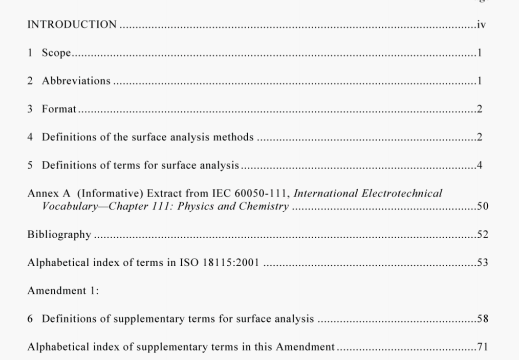AS ISO 18115 pdf download – Surface chemical analysis- -Vocabulary.
NOTE 2 The Tougaard background Is usualy calculated to match the measured epectwm over a wide energy range that excludes the peak region arid the spectral region extending to roximately 50 eV less kinetic energy than the peaks of wlterest. The measured spectrum should be corrected tor the spectrometer response function of the measuring Instrument before Calculation at the Taugaard background.
5.44
b.ckscattered cIctron
AES, EELS) electron originating in the incident beam which is emitted after interaction with the sample
NOTE t By convention, an electron with energy greater than 50 eV may be considered as a backscattered electron
NOTE 2 By convention, the incident beam le allen called the primary beam and the backscattered electrons are often referred to as the backecattered pnmaiy electrons,
5.45
backacattering ce.fflcl.nt backacattering yield
ElA. RBS) quotient at the number at detected particles in an interval 01 backscatiering energy by that iilarval and by the number of incident ions
5.46
backscatt.rlng energy
energy of a particle from the primary beam after it has undergone a backscattering collision and escaped from the sample
5.47
backecatt.nng factor
AES) factor defining the increase in the Auger electron current due to additional ionizations in the sample caused by backscattered electrons above that arislig deectly from the primary electrons
NOTE Different usages exist; the factor commoy the tractional increase, as defined above, and sometimes unity plus that fracbonal erease The latter usage a deprecated. For clarity, the particular usage needs to be defined.
5.48
backscatt.itng spectrum
(EtA, RBS plot of backscattering yield versus backscattering energy P1
5.49
backscatt.rlng yIeld
backecattering coefficient
(AES, EPMA) ratio of the total number of electrons emitted from the sample with energies greater than 50eV to the total number of electrons Incident at a given energy and angle of IncIdence
Cf. secondary-electron yield, total secondary-electron yIeld, backscatterlng factor
5.50
ball craterlag
a procedure in which the sample is abraded by a sphere in order to expose compositional changes I, layers below
the original surface with the Intent that the depth of those layers can be related to the lateral position In the crater
created by the abrasion
cf. angle lapping, radial sectioning
5.51
beam convergence angle
angular interval containing aft or a specified traction of the bean in the space prior to or at the focal plane
ci. beam divergence angle
NOTE 1 The bremsstrahlung radiation has a continuous spectral distribution up to the energy of the incident electrons.
NOTE 2 In XPS. The bremsstrahlung from a conventional X-ray source with an Al or Mg anode leads to a continuous photoelectron background. This radiation may also photoionize inner shells that would be energetically impossible by charactenstic Al or Mg Ka X-rays. As a result, Auger electron features may appear at negative binding energy values and, in addition, the intensities of other Auger electron features may be greater than if the inner shell vacancies had been created only by the characteristic X-rays. The bremsstrahlung-excited Auger electron features can be helpful in determining the various Auger parameters needed to identify chemical states.
5.70
cascade mixing
a diffusion-like process in which atoms of material are moved randomly by energy deposited by incident particles
slowing down in the sample surface region
Cf. atomic mixing, collision cascade. knock-on, recoil implantation
NOTE 1 If atomic mixing and knock-on effects are not significant, the measured spuller depth profile of a delta layer will be asymmetric on account of cascade mixing since the surface moves through the sample as it is sputtered. The initial internal profile produced will be Gaussian, however until significant delta material has been lost through the sample surface.
NOTE 2 If cascade mixing is the only significant mixing process, the centroid of the measured distribution will lie at the true delta position (after any shift in the depth scale arising from pre•equilibrium effects has been corrected).
NOTE 3 In the dilute limit, the measured depth profile for the delta layer will have an exponential tail because any internal atom has an equal probability of being moved deeper or shallower and there is thus an indefinitely persistent but decaying concentration in the near-surface region. The presence of this tail often leads to the belief that there is a directional knock-on process at work. True knock-on effects have rarely if ever been observed, and are probably not significant as causes of sputter profile distortion.
5.71
channelling
preferential motion of energetic particles along certain axial or planar directions of a crystalline solid as the particles move through the sample
NOTE The potentials of the individual atoms of the solid combine to reduce the scattering of the energetic particles from these directions.
AS ISO 18115 pdf download – Surface chemical analysis- -Vocabulary
